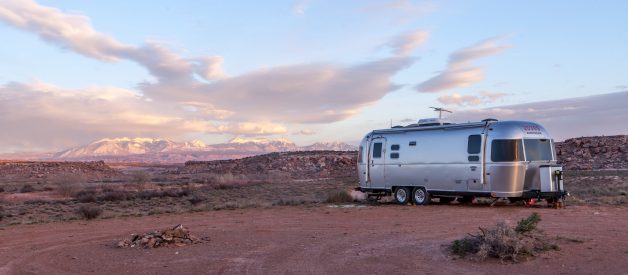5 Reasons Why Buying Pre-1999 Will Improve Your Travel
So, you?ve seen the shows, books, and blogs and you?re thinking that a camper trailer might be just the thing to set you free on a life of adventure and exploration. Or maybe you move around a lot and you?re tired of searching for a new apartment that will let you bring your cat but also isn?t a dump and doesn’t cost as much as a mortgage.
In any case, you?re looking into getting yourself a sweet new camper trailer! However, when you Googled some models and dealerships the price nearly made your eyes fall out of your head. ?What are they even Charging me for?!?? you asked in dismay as you browsed through a website. ?I could buy a whole house for that price!? you realized.
So, here you are, rightly thinking that something older and used could work just as well and at a much nicer price. Luckily, you?re absolutely right!
Just like with cars, new travel trailers lose a Lot of their value as soon as you take them off the dealership asphalt. I?ve seen people say they lost as much as 30% of the value of their RV or trailer immediately after buying it! That being the case, you can save a ton of money getting a used camper trailer. But I?m going even further than ?used? and telling you to buy an Old camper trailer. By old, I mean pre-1999 construction. That?s right, I?m telling you to buy a camper that?s already at least 20 years old. It may sound crazy, but it?s not.
The following are 5 reasons why pre-1999 campers are the best choice for you and your family; they?re inexpensive, they?re better quality, there?s more variety, they?re DIY-friendly, and they?re stress-free.
Let?s start off with the most important factor; the budget. I did literally Months of research before buying my used travel trailer. I trolled the blogs and the RV sites and Craigslist almost every day. I read article after article. Here are a few of the ones I read (and reread).
The Best Way to Avoid Buying a Defective RV
I have bought and sold many RVs over my 50 years of RV ownership and want to help people to avoid RV buying and selling?
axleaddict.com
How to Know If an RV Is Well Designed and Constructed
I am an RV enthusiast with more than 50 years of experience owning, driving, traveling and living in recreational?
axleaddict.com
How to Know What an RV Is Worth
I have had a great deal of experience both buying and selling RVs and think people should understand the mechanics of?
axleaddict.com
How to Keep From Making the Worst RV Buying Mistake Ever
I have bought and sold many RVs over my 50 years of RV ownership and want to help people to avoid RV buying and selling?
axleaddict.com
Yes, all of these articles are about RVs, but I found that the advice held true for tow-behind vehicles as well (just ignore anything about the engine). If you Google ?Buying a used travel trailer? or ?buying a used RV? then you?ll find a boatload of good information. Lots of people have written articles just like this one about how to choose the right camper trailer for you.
To sum up what I learned from all of my reading, you can buy a 5-year-old camper trailer that is still in pretty good shape and save yourself that 30% depreciation. For a 5-year-old camper trailer, you can expect to spend over $10,000 on most models. However, that?s still a lot better than the $15k or $20k (or more!) that they?re asking for new campers. At this age, the campers are still lightly used and might even be better than new, as the first owner usually works out the kinks and makes all those little improvements that can make a trailer more comfortable.
So, saving 30% is pretty good. However, you can save a Lot more by getting something that?s over 10 years old. If you?re like me, $10,000 for a used camper is still way over-budget. I was looking at something more like $5,000, and hopefully less. Most 10-year-old (or older) trailers are priced between $4k and $10k, with $4,600 as the average price (according to NADA). That?s a really good deal! If you look at the price of a steel framed trailer with nothing on it, you?ll see that almost any camper trailer is worth the money at that price. I found pre-1999 trailers in a range of quality with prices between $3,500 and $7,000. In my opinion, anyone asking more than that (used RV dealerships *cough* *cough*) is trying to swindle you. Unless they have some really fancy updates, nothing can change the fact that they?re 10?20 years old and not getting any younger.
There are other ways to save even more. Looking in the fall and winter will get you better prices. People have just finished summer with their camper and either they used it for the last time, or they realized they haven?t used it in years. They?re wanting to sell it so they don?t have to face another whole year of seeing it on their lawn or in their garage. The Used RV dealerships have their biggest sales in spring and summer, so in fall and winter, they?ll be hurting for income and more willing to bargain. Always compare the prices to the NADA price, which is the average for that make and model in your area.
Research RV Prices & Values
Research the latest RV prices, book values and motorhome MSRP prices for all RV manufacturers.
www.nadaguides.com
With new campers going for $20,000, and 10-year-old campers going for less than half that, you?re going to get some pretty big savings. A camper that?s more than 10 years old will probably cost less than $5,000. That?s money saved that you can put towards an extra week on the road or a fancier campground with lake-front access. However, I?m not telling you to buy a 10-year-old camper. I?m telling you to buy a pre-1999, 20-year-old or Older camper. So what makes 20-year-old campers better than 10-year-old campers when the price is similar? Read on!
2. Better Quality
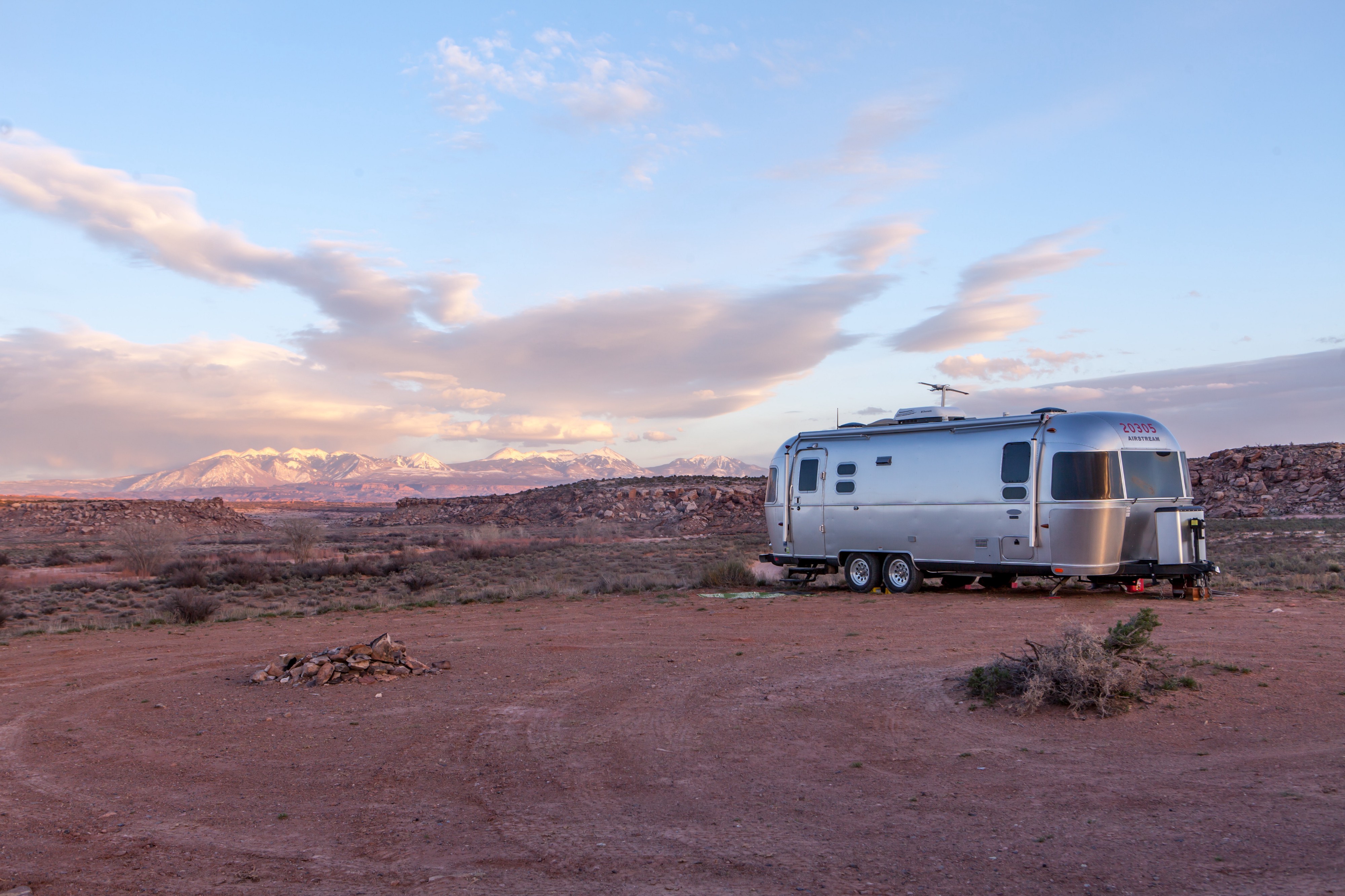 You can’t afford this. They sell rotted out, completely rusted old Airstreams for $10,000.
You can’t afford this. They sell rotted out, completely rusted old Airstreams for $10,000.
Older trailers are better quality. And by older I mean pre-1999. I dug deep into the RVing dark web and found out that many of the RV Company names you can think of (Dutchmen, Airstream, Keystone, Jayco) are all owned by the same company, Thor Industries. (https://www.thorindustries.com/get-to-know-us/meet-the-companies/)
Almost all of the other common RV and trailer brands are owned by Forest River Inc. Together these two own about 80% of all the RVs and travel trailers being made today. These companies used to all be separate, with differences in manufacturing quality and design. The big merger of companies and brands happened in the early 2000s, starting in 1999. Thor and Forest River began buying up other manufacturers but continuing their brands, giving us the illusion of choice without the substance. At that time, Thor and Forest River decided to switch from ?quality? to ?quantity? and the quality of RVs and travel trailers took a big hit. They started cutting corners, using the cheapest materials and paid very little attention to functionality, longevity, and even safety. So, almost all of the brands you can think of are made in the same factories, with the same components. This lack of competition also leads to lack of quality since if you want a better trailer? you?ll probably just end up buying a different brand that they own. The company gets your money either way.
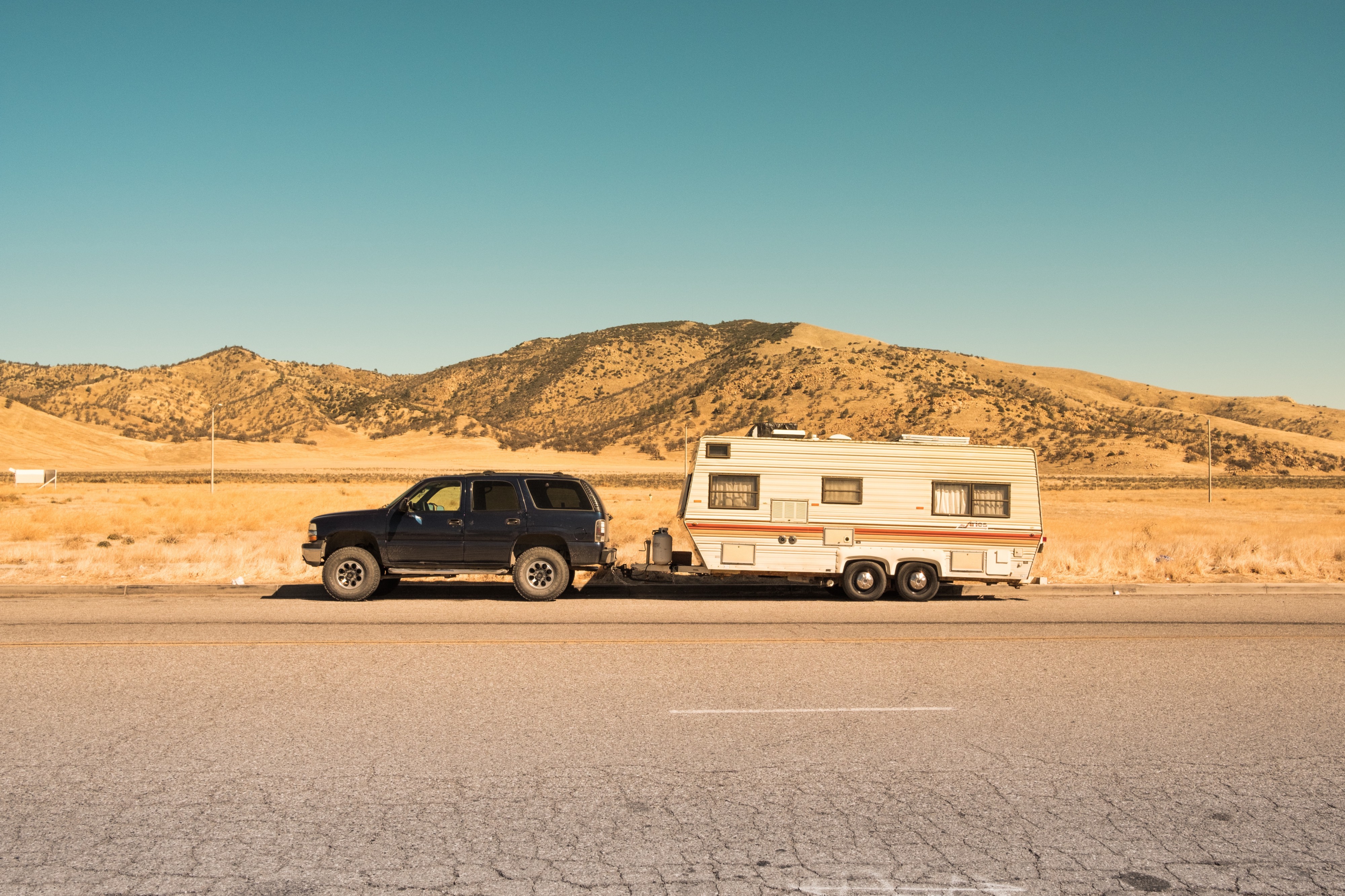 Being stranded due to substandard parts will not improve your vacation.
Being stranded due to substandard parts will not improve your vacation.
Even more unfortunately, there are very few regulations to follow when it comes to the interior of the RV or travel trailer. Although the brakes, frame and other basic parts have to be safe, your microwave and cabinets are not being held up to any standard. The RV industry is self-policing and most states have no ?lemon laws? to penalize companies for selling sub-standard products. ?Buyer beware? is the name of the game in the RV industry. I?ve heard many a long-time RVer complain about the bad quality of Lippert components, and Lippert provides a great many components for Thor Ind. and Forest River Inc.
Bottom line is, the quality of travel trailers and RVs has gone down significantly since 1999 when Thor Ind. and Forest River Inc began buying up smaller manufacturers. With that information in hand, I decided to search for pre-1999 trailers. I wanted something solidly built with quality construction and materials. I wanted it to be reliable and to last. I was willing to do some DIY to make it look how I wanted so I wasn?t afraid of something a little older. Now, maybe you?re imaging that rusting hulk in the neighbor’s backyard. No worries, many of these pre-1999 trailers are still on the road and going strong! They were built better, so they lasted longer. If your purchase quality to begin with, you?ll save yourself a lot of headaches repairing everything that breaks. You?ll also get much more use out of your trailer.
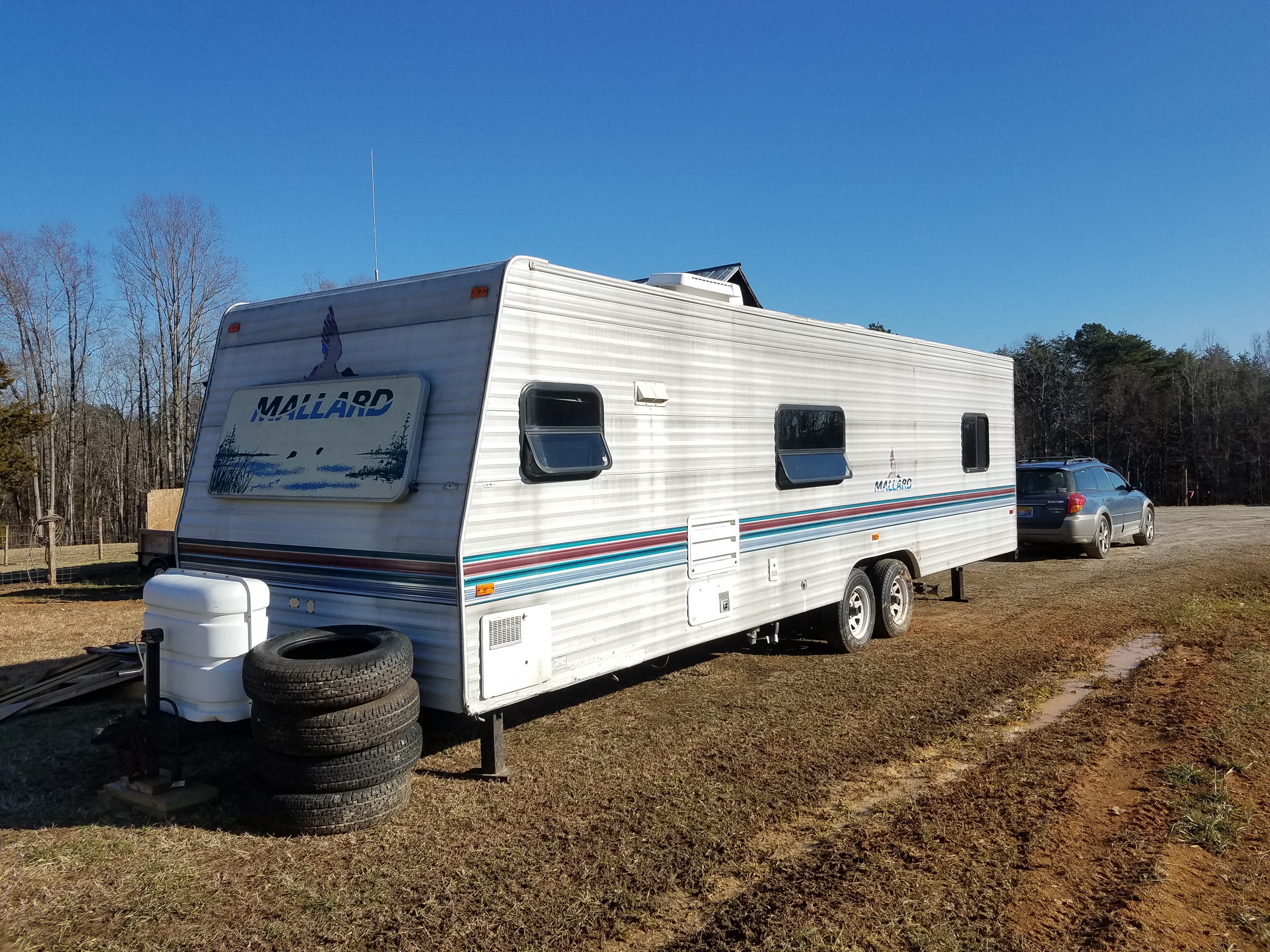 My 1997 Fleetwood Mallard, well-taken care of and in good condition, for only $3,500!
My 1997 Fleetwood Mallard, well-taken care of and in good condition, for only $3,500!
3. More Variety
Variety in travel trailers is mostly limited to size, weight, and floor-plan. As you start looking at pre-1999 trailers, you?ll find that they differ from new trailers in several ways. The age of your travel trailer or RV will have a huge impact on important things like it?s weight and the floor-plan. Weight is critical to your purchasing choice because Gross Vehicle Weight Rating determines if you can tow it and Carrying Capacity determines how much of your stuff you can put in it. You?ll need to look for something that is within your towing capacity and has the bones to carry all of your camping equipment, pots and pans, and clothes.
Although newer ?ultralight? versions of travel trailers sound good, lighter isn’t necessarily better. The 1997 Fleetwood Mallard pictured above is 30ft long and its weight without any personal items (Dry Weight) is only about 4,000 lbs. It?s Carrying Capacity (CC) is over 2,000 lbs, leaving plenty of room for your stuff. Together, these two numbers give a Gross Vehicle Weight Rating (GVWR) of 6,800 lbs. That?s the maximum weight of your trailer when it?s loaded full of all your stuff.
Newer trailers usually have a lower Dry Weight, closer to 2,000 or 3,000 lbs. That?s good, but their Carrying Capacity is limited; usually to less than 1,000 lbs. This means that the GVWR is usually 4,000lbs and sometimes less, which is technically lower than older trailers. The catch is that you can?t bring as much stuff without overloading the trailer and potentially damaging the brakes or steel frame. My research indicates that most people need at least 1,000 lbs of CC, and if you have a lot of kids or you?re planning longer trips, you should really have more. Those pots and pans, bikes, sleeping bags, camp chairs, and clothes add up. A stocked refrigerator can be over 100 lbs. You?d be surprised by how much all of your stuff weighs.
An overloaded trailer is a potential roll-over hazard from popped tires, putting everyone on the road in danger, including yourself. A roll-over will reduce your trailer to splinters of wood and aluminum the highway, destroying your belongings and resulting in serious injury or death. Carrying Capacity can?t be overlooked. These ?ultralight? new trailers are lighter, but you?d better pack lighter as well. You?ll find a much wider selection of travel trailers within your weight range if you look at pre-1999 models.
Floor-plans are another thing to consider. Newer trailers have many different floor-plans to choose from, built to accommodate one or two all the way up to a large family. Older trailers have a similar variety of floor-plans from a wide range of model years. Search Craigslist for pre-1999 trailers and pay attention to the layout. Older models used different layouts than the new ones do. One thing I really appreciate about older models is that they have larger kitchens. Used RV dealerships have a lot of pictures and sometimes walk-through videos. Look at these sites to get an idea of what size and floor-plan you want.
New & Used RVs for Sale on RVT.com – Travel Trailers, Motorhomes, Campers and More – Sell an RV?
RVT.com has thousands of New and Used RVs for sale. Millions of RV traders use RVT.com classifieds to Buy and Sell RVs?
www.rvt.com
New & Used RVs – Motorhomes for Sale – RV Trader
New and used RVs For Sale by Owner or by Dealer. Find, Buy or Sell RV Motorhomes, Travel Trailers, Fifth Wheels, 5th?
www.rvtrader.com
So, why go pre-1999? Before so many of the manufacturers were conglomerated into Thor and Forest River, there was a wide variety of different floor-plans and designs to choose from. Different companies catered to different lifestyles and tried to include unique or interesting layouts to entice buyers. These older trailers reflect the differing needs and desires of the previous generation of travelers. Longer trips with the whole family were more common back then, so you?ll find better accommodation for kids and for cooking. For me, that was exactly what I wanted. Newer trailers are much more cookie-cutter in appearance, reflecting the single vision of the company that owns them.
Also, when looking at older trailers there are simply more to choose from. While RV companies are still producing new travel trailers every year, they tend to stick to a few models for everything they build. On the other hand, the used RV lots are full of models from every company and every year. You?ll find that there are many, many more used and older trailers on the market than new ones. On average, people only keep their RVs and campers for 3 years, and then they go on the Used RV market. If you spread your search net wide, you?ll be able to pick and choose until you find something that?s just right for you.
4. Do-It-Yourself (DIY) Friendly
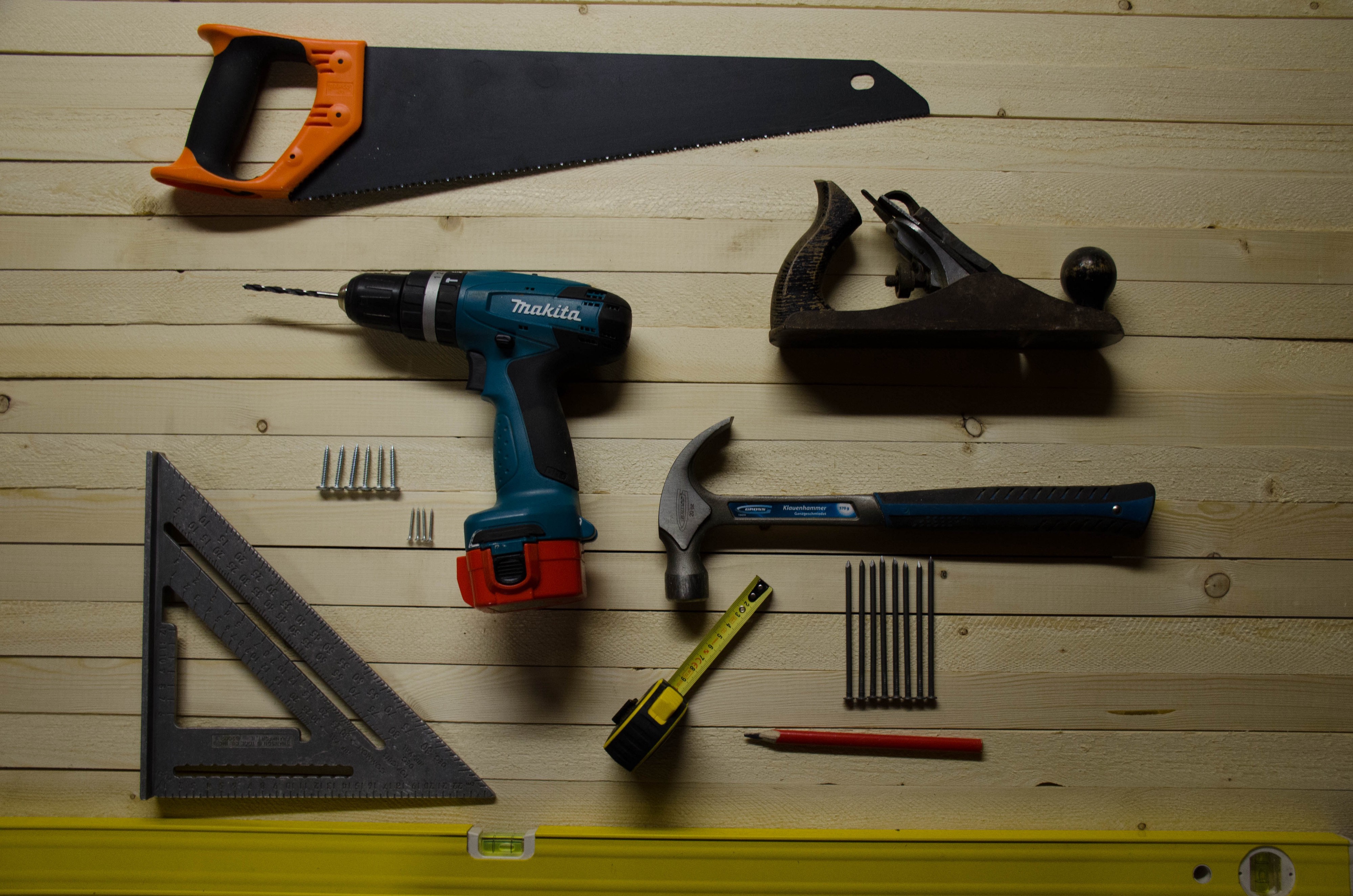 Photo by Eugen Str on Unsplash
Photo by Eugen Str on Unsplash
You don?t need to be afraid of DIY when it comes to your RV or travel trailer. Unlike with a house, there are no building codes to follow (although safety should always be considered) so you have a lot of leeway to ?make it work.? In my DIY experience, I also found that most campers are built very simply. Unlike your house, there?s no drywall, only a thin sheet of plywood over the insulation. Everything is light, simple and made with as few parts as possible.
Pre-1999 campers are especially simple. They used wood wherever they could rather than plastic or fiberglass. Wood is much easier to repair and replace than specially-fitted plastic parts. Luan paneling is easy to paint or replace if it?s damaged. The roof on pre-1999 campers is usually a thin sheet of aluminum, providing superior waterproof protection as well as an easy surface to cut or patch, unlike newer trailers that require spending thousands on a rubber roof.
Most likely, your 20-year-old trailer will need some work, even if it?s just a new paint job and updating the upholstery (90?s prints are so out). However, that?s not necessarily a bad thing. Your travel trailer is your home-away-from-home while you?re on vacation, and that can either be a good thing or a bad thing. Doing some DIY is your opportunity to personalize the camper for your family and your needs.
If you go to the beach a lot, putting in some extra towel hooks and rigging a curtain to make the kitchen into a quick changing area could really help. Add some beach-themed decor and even a rainy day stuck inside will remind you that you?re on vacation. If this old camper is going to be your hunting cabin, then finding space for a big chest freezer in the mostly-unused kitchen could be a huge bonus. Or, like me, you could completely renovate to make a 30ft camper your full-time home! Having never renovated anything in my life, I found the camper a very un-intimidating project. Each room is so small, it doesn?t take long to fix it up. I?m changing almost everything and the simple construction is easy to work with.
So, why are older campers better for DIY? For one, it?s really hard to rip into some shiny, brand-new trailer, even if it?s not what you want and you planned to do it all along. You?ll cringe just thinking of it. In an older trailer, the wear-and-tear makes you feel good about bringing life back into a dusty, unused space. For another, newer trailers use plastic for everything and plastic is very hard to work with. If it cracks, it?s all over. Paint flakes off it. You?ll have to specially order a replacement part that they?re going to overcharge you for, or may even be out of production and impossible to find. With the wooden parts in older trailers, you can shave off parts, nail on new shelves, paint or stain, and many other options. You can cut a new piece to fit from something leftover from another project. You can make it work and still look good. If you?re a DIY kind of person and you like to save money, an older trailer will be perfect for you.
5. No-Stress
 Photo by Fernando Brasil on Unsplash
Photo by Fernando Brasil on Unsplash
The last, and maybe the best thing about buying a pre-1999, 20-year-old camper trailer is that they?re stress-free. You didn?t spend a million bucks. You?re not making crazy monthly payments. You don?t have a very expensive investment sitting in your driveway tempting burglars and hail and teenaged drivers. Your kids aren?t going to cost you hundreds by slamming the door too hard, and your annoying cousins aren?t going to break the brand new whatever-it-is the first time they borrow it for a weekend.
Think of all the things you won?t have to worry about. You?re taking something apart for some DIY work and your crowbar slips and ? Crack ? there?s a new hole in the wall. You just shrug because who cares? The trailer is old anyway. What?s one more hole? You put that on the list of things to fix and move on. Another scenario; you?re going down the road and a huge rock makes a nice big dent and scratch on the exterior paint job. No worries, what else can you expect on a used trailer? Or, an unwary driver accidentally backs his trailer into yours in the campground. No problem, just patch it up and move on. A few years down the road you take a vacation with the kids and the dirt, scratches, chips in the paint, finger paint on the floor, and a million other inevitable damages occur. It?s not a big deal, you only spent a few thousand on this trailer anyway. You?ve already gotten your money?s worth out of it.
Statistically, most people who buy a camper trailer or RV only keep it for 3 years before selling it. The kids grow up. Your job changes and you lose vacation time. Your job changes and you can’t afford the monthly payments on that new trailer anymore. Next thing you know, you?re trying to sell the no-longer-new trailer that isn’t even worth what you owe on it. Your ?investment? didn’t pay off. Unfortunately, this isn?t a rare occurrence for people who buy newer trailers and RVs.
When you buy an old trailer you?re making an investment that won?t weigh you down like an anchor in a few years. It?s nearly impossible to lose money on old campers since you bought it at rock-bottom prices. You can take a deep breath and let go of all the worry about making payments, using it enough to justify the expense, trying to protect the shiny new paint, and making annoying calls to warranty agencies to replace that broken thing. I can promise you that being free from all that stress and worry is a huge benefit of owning a pre-1999 camper trailer.
So, now that you?ve considered all of the benefits I?m sure you?re convinced. When you buy a pre-1999 camper trailer you?re spending less, getting better quality, choosing from a greater variety, getting something that?s DIY-friendly, and saving yourself a lot of stress in the future.
Good luck on your travel trailer buying adventure! I hope you find the perfect adventure-mobile for your family.
If you?re looking for tips on renovating your old camper, check out my blog where I strip a 30ft 1997 Fleetwood Mallard down to the studs and build it back up for full-time living.
